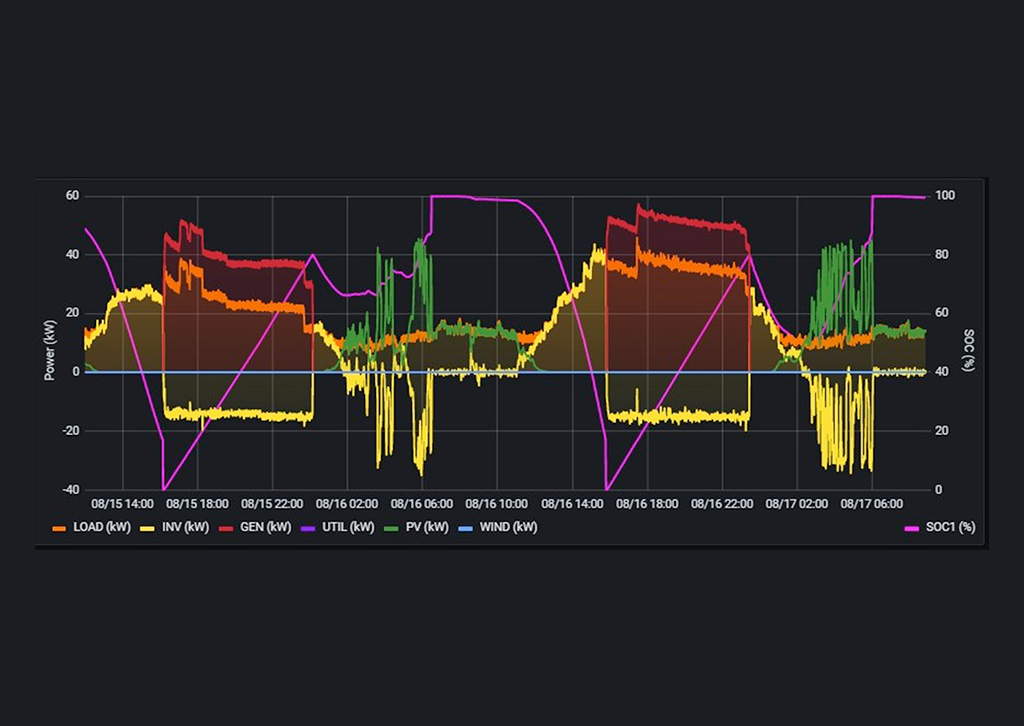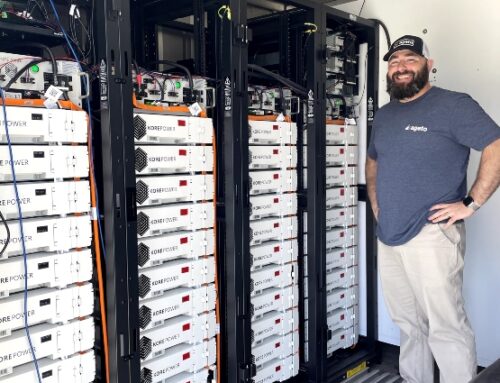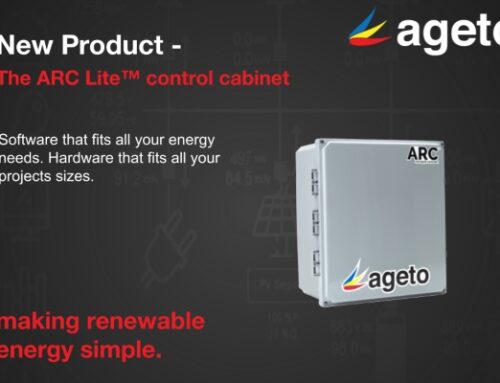As we have come to fully understand the impacts of climate change, it has become clear that to meet our climate goals, there needs to be an immediate and drastic shift away from carbon-based fuel. While going to 100% renewable energy is of course the ultimate goal, the path to implementation is a long one. While grid-tied facilities and the utilities on the other end have their own renewable energy goals and commitments, off-grid electrical systems are left in a unique position. Not constrained by interconnection requirements and other bureaucratic hurdles, off-grid systems face the opportunities, and challenges, of a closed system.
Off-grid electrical systems often supply locally generated power to remote or island communities. A common thread between these communities is their local power generation takes the form of a fossil fuel based generator power plant. Almost all of these off-grid electrical systems start off with generators. The question becomes whether to add solar, battery storage, or both.

Solar+Battery Storage Microgrid
Well first off, if the goal is to be 100% renewable energy, why not just rip out the generators and create a solar+storage only system? Unfortunately, at current battery prices, this is still almost entirely unfeasible for budget-constrained projects. For solar and battery storage to handle the largest load in the worst possible conditions (multiple days of clouds, snow on the panels, etc.) both would have to be sized so large the project costs would be unreasonably high. It is far more feasible to achieve a 97% renewable energy target. As the renewable make-up target nears closer to 100% renewable energy, asset sizing, and therefore project cost, grows exponentially.

Solar+Generator Hybrid Microgrid
Solar is a tried and tested technology coming from an industry that has been maturing for decades. The addition of solar in many potential projects can pay for itself in just a few years. The addition of solar to an off-grid electrical system offsets costly and polluting carbon based fuels. However, solar is an intermittent resource and cannot operate alone. This means a generator must always be running. If a generator is running, it must be running above a minimum loading setpoint. This means solar energy may need to be curtailed to avoid overloading the system. While the lowest initial capital, the operational costs of constantly running a generator, and keeping other generators online as spinning reserves can bring up the lifetime costs of a solar+generator hybrid microgrid project. Typically, up to 20-30% fuel reduction can be achieved with a solar+generator hybrid microgrid.
Solar+Storage+Generator Microgrid
The deployment of a hybrid off-grid electrical system achieves the goldilocks balance of “just right”.
Gen-off operation
Adding storage means there are now two grid-forming resources in the system. This allows for generator-off, renewable-only operation when the conditions are right. This saves fuel, decreases generator run hours and decreases noise pollution for the community. Community who’s residents have often become accustomed to listening to the generator chug along as a background to their life.
Optimal loading
When making the investment in a generator, just as any asset, it is important to understand and implement the necessary requirements to keep operation and maintenance costs at a minimum. The addition of storage can assist in keeping the O&M costs down in many ways. Generators have a minimum loading and a range of maximum efficiency. Adding battery storage to a system allows the flexibility to operate in the maximum efficiency range. The batteries sink power to be used later if the load drops or provide power to avoid starting another generator if the load jumps or clouds drop the solar production.
Spinning Reserves
Arguably one of the most valuable advantages of storage in an off-grid electrical system is the ability to provide additional spinning reserves. This can mean additional generators do not need to be kept online, poised to pick up the load. Utilizing advanced control methods, the storage can even seamlessly take over the full load if a generator faults offline without warning. This was the case in the Ageto off-grid electrical system or community microgrid powering the remote village of Shungnak, Alaska. With no prior warning, the generators tripped offline, but the residents didn’t even see a blink in power when the energy storage seamlessly took over the full load.
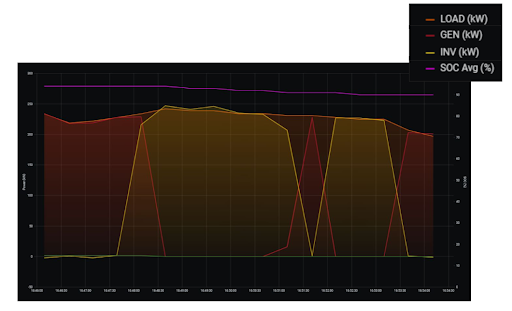
Cycle Charging
Cycle charging is a term used in the microgrid space to describe the energy management strategy of using excess power produced by a generator to charge the energy storage, typically found in off-grid electrical systems. It allows for the generator to operate in the optimal loading range, minimize the number of run hours, and lessens the likelihood of the generator needing to start multiple times a day. All of which saves on yearly maintenance costs and extends the life of the generator. Not to mention it can eliminate hours of noisy generator sounds for a community.
A generator can run at full capacity using all excess power for charging. Alternatively, it can “follow” the load producing a certain amount above the actual consumption to charge the batteries at a constant rate. This picture comes from Ageto’s web-hosted dashboard for minigrid project in Totota, Liberia, where load-following cycle charging is used to optimize the system.
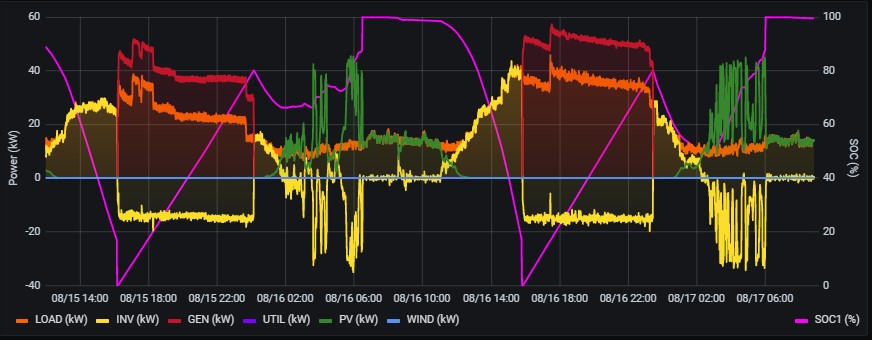
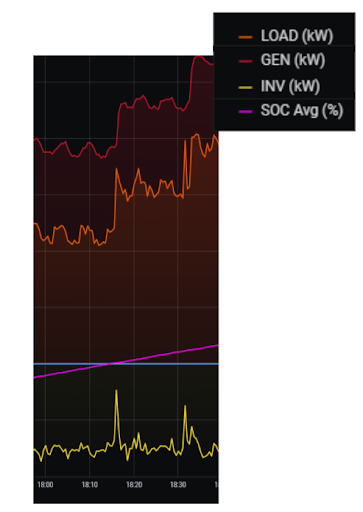
The unusual load jumps in this project also demonstrate the efficacy of energy storage. With sudden spikes of 10 kW or higher, the battery storage dispatches instantaneously to meet the load while the generators ramp slowly.
Voltage support, Frequency Regulation and Power Quality Correction
Providing grid stability through voltage support and frequency regulation, although arguably less flashy than backup power, is nonetheless an incredibly valuable benefit in off-grid electrical systems. Many battery storage inverters are able to ramp to nominal voltage in milliseconds. The agility of the energy storage contrasts the slower moving generators, responding to fluctuation in the grid by stabilizing voltage and frequency on the sub-second cycle.
Conclusion
There is a great case for energy storage to be made in off-grid electrical systems. Of course, the addition of energy storage does not come without complications. With the addition of another energy resource the complexity of system design and complexity can increase far beyond solar and generators or generators alone. To bring the value out of the energy storage in these hybrid microgrids, an advanced microgrid controller is needed to orchestrate the resources to perform in harmony. Although all of the benefits discussed above are possible, it does depend on the advanced capabilities of both the selected energy storage system and the microgrid controller.
Have questions on how energy storage can benefit your off-grid electrical system? Need a place to start? Get in touch with the team of microgrid experts at Ageto.
